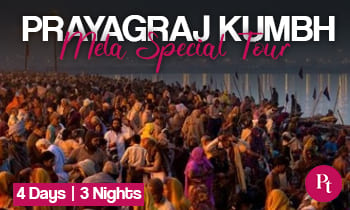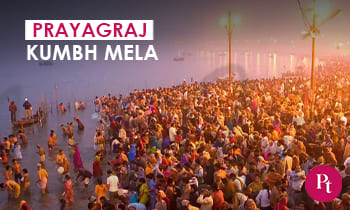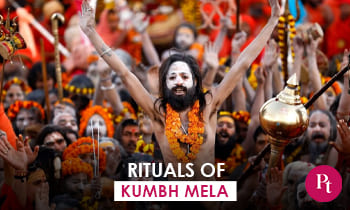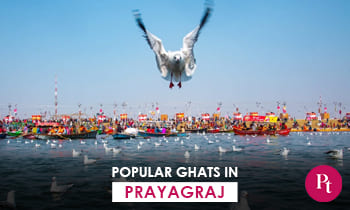The Kumbh Mela is one of the most religious Hindu events. In 2025, devotees from different parts of the world will converge at Prayagraj, to partake in the Kumbh Mela. During this sacred event, devotees from different corners of the world take a dip at Triveni Sangam to cleanse their sins and purify their souls. During this time the celestial alignments are believed to amplify the Kumbh Mela site’s spiritual energy, making it one of the best times for self-purification, meditation, and prayer. The Kumbh Mela showcases a blend of different traditions, including spiritual discourses, devotional music performances, Shahi Snans, and yoga sessions, making it the perfect convergence of community, faith, and culture. Apart from the Kumbh Mela site in Prayagraj, there are many other famous attractions that you can visit during your tour. Let’s take a look at the famous places you can visit during Kumbh Mela to have the best experiences of your life.
Top Tourist Places You Should Not Miss Out During Kumbh Mela
Let’s take a look at the famous tourist attractions in Prayagraj you should not miss out during your Kumbh Mela excursion.
Akshaya Vat

Akshaya Vat is situated within the Patalpuri Temple’s sacred grounds. It holds immense prominence in Hindu mythology. This sacred fig tree is considered to be immortal, attracting those who seek blessings, spiritual enlightenment, and divine grace. Around the tree, devotees perform circumambulation (pradakshina) and offer prayers, incense, and flowers to honor its divine presence. Those visiting Akshaya Vat can explore the architecture of the temple, participate in various rituals, and marvel at its ancient sculptures. During Magh Mela and Kumbh Mela, the temple complex resonates with religious processions, the sounds of devotional songs, and rituals performed by priests.
- Check out: Prayagraj Kumbh Mela Tour Packages
Patalpuri Temple

Patalpuri Temple is one of the holiest shrines in Prayagraj (Allahabad). It is situated in the Prayagraj Fort complex and is believed to be visited by Lord Rama. The temple was built in honor of Lord Vishnu and it dates back to the Mughal era. This underground temple was also visited by the Chinese writer and traveller Hiuen Tsang. The temple complex houses one of the country’s oldest trees- Akshaya Vat. It is also believed to be the place where the Ganges River emerged for the first time on the earth. Due to this, the temple is linked with the Triveni Sangam, which is believed to be the confluence of the Yamuna, Ganges, and Saraswati rivers. The underground chambers of the temple are believed to be the entrance to the Patal which denotes its name “Patalpuri.”
Allahabad Fort

Constructed by the Mughal Emperor, Akbar in the year 1853, Allahabad Fort is known for its architectural magnificence and historical importance. It stands on the banks of the confluence of rivers Yamuna and Ganga. However, access to the fort is closed. Tourists can only get inside the fort during the Kumbh Mela. The Archaeological Survey of India manages the fort. The fort also houses Akshayavat Tree which was used to commit suicide by the locals to attain salvation. If you want to see the Akshayavat Tree, you can enter through a small gate to the place occupied by the magnificent tree. The Fort also houses the Patalpuri Temple, which is believed to be home to the gates of hell. There is also an Ashoka Pillar that is around ten meters tall and was installed in 232 BC.
Hanuman Mandir

Hanuman Mandir is situated near the Allahabad Fort and is dedicated to Lord Hanuman. The temple is also known as the Bade Hanumanji temple or Lete Huye Hanuman temple. You’ll find here Lord Hanuman’s idol in reclining posture. The colossal statue is 8 feet in width and 20 feet in length and it lies a couple of feet under the ground. This is the world’s only temple which has been built below the ground. Here the seat of Lord Hanuman’s idol has been tilted backwards. During Hanuman Jayanti, special ceremonies and poojas are conducted at the temple.
Khusro Bagh

Khusro Bagh was built by emperor Jahangir in the early seventeenth century. It is a picturesque garden that houses the tombs of Jahangir’s family members, namely Khusrau Mirza, Shah Begum, and Nithar Begum. It is one of the greatest remnants of the Mughal architecture and it witnessed the turbulent culture and history of India. It has also been a part of the Nehru-Gandhi family legacy, the Indian Revolt of 1857, and the Prayagraj cityscape. The garden spans over an area of forty acres and is surrounded from all sides by a high wall with four gates. On the west side, lies the main gate that has an inscription attributing the garden’s construction to Aqa Reza. It is the ideal destination to explore the architecture and history of the Mughal era.
Anand Bhavan

Anand Bhavan is a national heritage site and a museum in Allahabad. It was the Nehru-Gandhi family’s home and the Indian freedom movement’s center. Motilal Nehru built it in 1930 as a comfortable and spacious residence for his family. It showcases the photographs, books, paintings, and personal effects of the Nehru-Gandhi family. You can also find here objects and documents related to the independence movement of India. The library houses around 30,000 journals, books, and manuscripts read and collected by the Nehru-Gandhi family. Some valuable and rare books, like the original copy of The Discovery of India and the first edition of the Gitanjali, can also be found here.
Mankameshwar Temple

Mankameshwar Temple is situated on the banks of River Yamuna in Allahabad’s Cantonment area. It is located near the Saraswati Ghat and attracts pilgrims from all around the world. It is dedicated to Lord Shiva and houses a three and a half feet Shivling which is believed to have been installed by Lord Ram. In the temple complex, you can see a Banayan, a Peepal tree, and the idols of Lord Ganesh, Nandi, and Lord Hanuman. The temple also houses Rann Mukteshwar Shivling. The most significant event at this temple is the Maha Shivratri festival’s celebration. During this festival, grand festivities are witnessed within the temple premises, including devotional singing, colorful processions, and cultural performances.
Alopi Devi Temple

Situated near the holy Sangam in Allahabad, Alopi Devi Mandir is an ancient revered by the Hindu faith. It has a wooden chariot called a doliê in place of a presiding deity which is mostly worshipped by Lord Shiva’s devotees. It houses the last of the body parts of Goddess Sati and is considered to be one of the most prominent Shakti Peethas in the country. In the middle of the temple courtyard, there is a platform where a pool is made. There is also a cradle or hammock, which is covered with red cloth. Devotees who visit the temple need to touch the cradle and seek the blessings of the Goddess Sati. On temple premises, you can also see the idols of Nava Durga and Lord Hanuman.
Allahabad Museum

Allahabad Museum is one of the best places to learn about the independence movement, culture, history, and heritage of India through the display of artifacts. It is divided into sixteen galleries, each one displaying a different sect of art and historic collections. There are different galleries in the museum each devoted to Jawaharlal Nehru and Mahatma Gandhi. The Gandhi Gallery displays Gandhi’s rare pictures from his childhood till his death. The other valued possession of the museum is the Gandhi Smriti Vahan, the Ford truck on which the ashes of Gandhi were immersed on 12 February 1948 in the Triveni Sangam. Chandrashekhar Azad’s pistol has been preserved and displayed in the museum’s entrance hall.
Triveni Sangam

Triveni Sangam is known to be one of the holiest destinations in Central India. It is the confluence point of three rivers – mystical Saraswati, Ganga, and Yamuna. It is one of the few sites in India where the Kumbh Mela is organized once every 12 years. It is believed that by taking a holy dip in the holy Triveni Sangam you can free yourself from the cycle of birth and death and flush away all the sins. At the Sangam, you will also find makeshift wooden banks. To the Sangam, you can take a boat ride and witness the three rivers merging into one. You can also attend the evening Aarti ceremony wherein devotees gather to witness the lamps floating on the water and offer prayers.
Whether you are seeking spiritual growth, cultural immersion, or historical exploration, Prayagraj during the Kumbh Mela offers an unparalleled experience. These sacred and historical sites will deepen your understanding of India’s rich heritage, providing memories that will last a lifetime.











 Call
Call WhatsApp
WhatsApp Enquiry
Enquiry
Very informative article. Useful to persons visiting Prayagraj